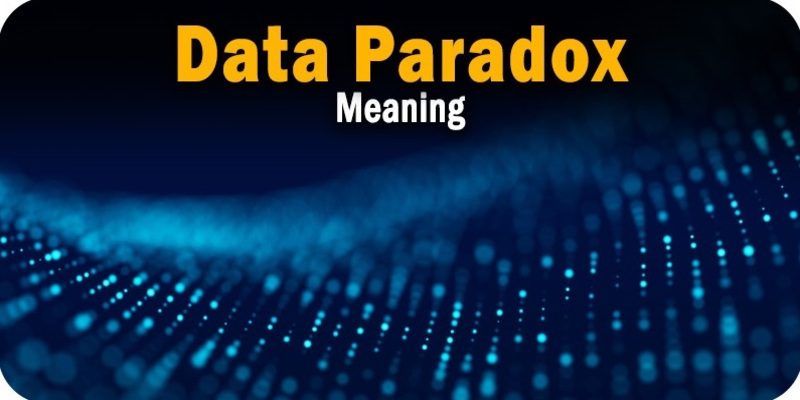Definition: Data Paradox Meaning and 101 Introduction


This is part of Solutions Review’s Premium Content Series, a collection of contributed columns written by industry experts in maturing software categories. In this submission, EPAM Systems CISO Sam Rehman offers a definition of data paradox meaning as an introduction to the topic.
 Companies desiring to reach new levels of personalization started collecting customer data as early as the 1980s. Their tactics have since advanced – now, they use artificial intelligence (AI) and other sophisticated tools to drive daily analytics. Today, there has never been a greater demand for raw data, nor has there been a more pressing need for security and privacy.
Companies desiring to reach new levels of personalization started collecting customer data as early as the 1980s. Their tactics have since advanced – now, they use artificial intelligence (AI) and other sophisticated tools to drive daily analytics. Today, there has never been a greater demand for raw data, nor has there been a more pressing need for security and privacy.
Considering the unimaginable amounts of information businesses collect, utilize and analyze every day, they must be responsible overseers for the sake of their customers and partners. This ‘data paradox’ of wanting more data while recognizing the obligation to protect it grows ever more paramount with the passage of regulations from global government agencies.
The Data Landscape Today
As data becomes a part of a connected ecosystem, it is more susceptible to attack. Recent years witnessed an alarming rise in cyber-attacks and data breaches via social engineering and ransomware, with 2021 seeing a 15.1 percent surge from 2020. Plus, the larger an organization’s data becomes, the greater the likelihood of vulnerabilities developing from misconfigurations, human error, or improper maintenance. Data breaches are particularly costly today because companies handle so much sensitive customer information.
The loss, theft, or destruction of this confidential data is expensive due to regulatory penalties – sometimes threatening the ability of a brand to continue doing business. Also, the consequences could damage one’s reputation, which can’t always be monetarily calculated. Another emergent concern is data privacy as it pertains to the demand for predictive machines, which use AI and machine learning (ML) algorithms to break down data into actionable insights. In light of these issues and challenges, businesses need the right tools to solve the data paradox, ensuring security and privacy from data capture until its deletion.
Anonymization, Synthetic Data, and Tokenization
The major tools available for data security are anonymization, synthetic data, and tokenization. Anonymization scrubs personally-indemnifiable information from data sets, keeping the person or entity the data belongs to anonymous. It allows companies to pursue digital transformation without jeopardizing their customers’ privacy or incurring penalties from regulators. Synthetic data, much like anonymization, is a method that creates generated data sets that match the semantics of the real data, unconnected to real-world events.
Primarily, synthetic data help train ML models and assist with use cases such as driving vehicles and fraud protection. Lastly is tokenization, which uses similar tactics to the previous tools as it exchanges confidential data with tokens or non-sensitive data. These tokens retain elements of the original data, like length and format, so organizations can safely use the data for business operations. Enterprises can also leverage data catalogs, scanners, and marketplaces when working in the data ecosystem. Nevertheless, to maintain consistent security, companies need to implement standard tooling procedures via data governance.
What is Data Governance?
A business can’t use its data securely or optimally without data governance. Indeed, the better a company understands its data (recognizing different classifications and domains through data maps), the more effectively it can defend that data and react to emerging threats. At its core, data governance is concerned with managing data availability, usability, and security via determined standards and policies. These procedures are created by the members of the data governance program, including a governance team, a steering committee, and a group of data stewards who work together closely to outline, implement and enforce these rules.
Robust data governance is essential to consistent and trustworthy data, preventing mismanagement or nefarious use. Likewise, data governance is critical as businesses begin to infuse data into their decision-making. An established governance program can ensure that the most qualified people are responsible for the final say rather than an algorithmically biased machine.
Driving Investment in Data Governance
Most businesses will undoubtedly invest in data governance programs to avoid the hefty penalties resulting from a preventable data breach. However, this investment is seen mainly as a form of compliance like paying taxes or putting new stickers on a license plate – rarely is a well-designed and adequately-staffed data governance program seen as something that can actually be a business driver. The reality is that data governance can be an invaluable resource for data scientists and engineers, as it enables insights and analytics to improve business efficiencies.
When there is structure and organization to a data ecosystem, data specialists don’t have to hunt endlessly for the data they need, nor are they ever confused about who they must ask for permission to use particular sets.
Starting Small
Like any puzzle, the data paradox can be frustrating. It can even be overwhelming. Attempting to structure massive amounts of data while aligning with security measures is no easy task, especially considering the vastness of the data ecosystem. Businesses must start every new data-related challenge by asking themselves: “what is the question we are trying to solve?”
Beginning each new project by answering a simple business question empowers organizations to focus and keep the scope as small and manageable as possible. Building the security fortress from ground zero allows one to isolate data they need, preventing it from proliferating too much. Moreover, an enterprise can unravel the data paradox by leveraging the right tools within a well-defined data governance framework.
































